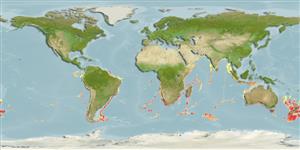Environment: milieu / climate zone / depth range / distribution range
Ecologia
marinhas batidemersal; intervalo de profundidade 360 - 1300 m (Ref. 44037). Deep-water
Southeast Atlantic: Walvis Bay to Durban, South Africa. Southwest Atlantic: Brazil. Southeast Pacific: Chile. Eastern Indian Ocean: southern Australia, from Western Australia to New South Wales and Tasmania. Southwest Pacific: New Zealand.
Tamanho / Peso / Idade
Maturity: Lm ? range ? - ? cm
Max length : 60.0 cm TL macho/indeterminado; (Ref. 6594)
Espinhos dorsais (total): 5 - 9; Raios dorsais moles (total): 0-1; Espinhos anais 10-18; Raios anais moles: 115 - 160. Pelvic fins with 1-3 spines, the first of which is rudimentary (Ref. 27363). Body dark brown, with darker fins (Ref. 27363) and mouth (Ref. 6594).
Occurs on the continental slope (Ref. 9563). Feeds on benthic copepods and polychaetes (Ref. 27637).
Life cycle and mating behavior
Maturidade | Reprodução | Desova | Ovos | Fecundidade | Larvas
Sulak, K.J., 1986. Notacanthidae. p. 195-196. In M.M. Smith and P.C. Heemstra (eds.) Smiths' sea fishes. Springer-Verlag, Berlin. (Ref. 6594)
Categoria na Lista Vermelha da IUCN (Ref. 130435)
Ameaça para o homem
Harmless
Utilização humana
Mais informação
ReferênciasAquaculturaPerfil para aquaculturaEstirpesGenéticaElectrophoresesHereditariedadeDoençasProcessamentoNutrientsMass conversion
ColaboradoresFotografiasStamps, Coins Misc.SonsCiguateraVelocidadeTipo de nataçãoÁrea branquialOutras referênciasCérebrosVisão
Ferramentas
Relatórios especiais
Descarregue XML
Fontes da internet
Estimates based on models
Preferred temperature (Ref.
123201): 2.3 - 10, mean 7.1 °C (based on 467 cells).
Phylogenetic diversity index (Ref.
82804): PD
50 = 0.5161 [Uniqueness, from 0.5 = low to 2.0 = high].
Bayesian length-weight: a=0.00102 (0.00046 - 0.00225), b=3.06 (2.88 - 3.24), in cm total length, based on all LWR estimates for this body shape (Ref.
93245).
Nível Trófico (Ref.
69278): 3.0 ±0.17 se; based on food items.
Resiliência (Ref.
120179): Muito baixo, tempo mínimo de duplicação da população maior que 14 anos (Preliminary K or Fecundity.).
Fishing Vulnerability (Ref.
59153): Moderate vulnerability (44 of 100).
